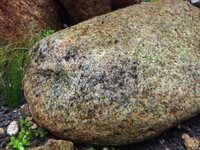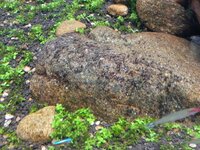OK, we'll start from the beginning.
KH is a measure of how much dissolved alkaline buffers are in the water.
Alkaline buffers, having a negative charge, attract and hold acid, which have a positive charge, thereby neutralizing acid.
Acid is essentially Hydrogen ion (H+). "+" means It has a positive charge.
Alkaline buffers such as (CO3--) have a negative charge (in this case a double "-" means it has a -2 charge and can therefore attract and hold 2 particles, each having a single "+" or 1 particle having a "+2" charge.
The negative charge of the CO3-- bonds to the H+ so that these positive charges are masked.
When you measure the pH of the water you are measuring the ratio of H+ to a different alkaline substance called Hydroxyl (OH-).
Can you see that when H+ combines with OH- you get [H:OH]? This is water, more commonly written as H2O. Although it's written as H2O it really isn't as if there are two Hs together. The first H+ bonds to the negative side of the OH- but gets as far away from the second H in OH as it can because in this situation they are both positively charged particles and so they repel each other.
In water that has a neutral pH (7) it turns out that there is an equal number of H+ and OH- floating around. At any one time H+ may bond to OH- to form H:OH, and the next moment they get broken apart and return to be free floating H+ and OH-. This happens continuously, however, on average, there will be an equal amount of the two.
When you add acid to this neutral water, a very similar thing happens with that acid. In your pool you would ad HCl which is a powerful acid that disassociates almost entirely into separate H+ and Cl- ions. Sometimes the odd H+ combines with the odd Cl-, but not very often. The H+ mostly hang around looking for trouble.
This "disassociation" changes the ratio of H+ to OH- in that water, so of course, when you measure the pH it will be lowered (acidic).
If we now add CaCO3 to the water, then the CO3-- will have a very strong attraction to the H+. They will combine to form H2CO3, and on average will stay combined. Some will again disassociate, but not very often. When this happens the extra H+ that were added to the water from the HCl addition are now removed from action (ie. they are not floating around as H+ anymore because they are joined to the CO3-- and they do not exert nearly as much positive charge "+" influence). So, if you now measure the pH, it will rise back up towards 7.
This is what happens when you overeat, get an upset stomach and then take some Chinese herb, or Alka-Seltzer in the West. Your stomach produces a lot of acid H+ in response to the food and whatever herb you then swallow HAS to be some form of alkaline buffer. In the case of Alka-Seltzer, or Tums, or whatever, it's just lime or bicarbonate. In your stomach the carbonate or bicarbonate bonds to the H+ and reduces their impact against tissues which are easily damaged by large quantities of positively charged H+.
If you tell me that your water has a low KH then that tells me immediately that there are not very many alkaline buffers in the tank. The CO2 produces a small amount of the weak Carbonic acid, and because there are few buffers in the water the ratio of H+ to -OH rises rapidly and so the pH falls rapidly.
If you then add alkaline buffers to the water, all that happens is that you "mop up" the free floating H+ with the buffers and the pH will rise. You would not have done ANYTHING about the CO2 content just by adding the buffers. You would just be affecting the pH reading that results from the same amount of Carbonic acid.
So when people have low KH water, a very small added amount of CO2, which produces a very small amount of Carbonic acid, has a tremendous impact on the pH because there are few alkaline controls. This would give a false sense of security because the problem in the tank is that there is a very small amount of CO2.
Because pH drop is our only indicator, we have to be aware that small amounts of CO2 generate large amounts of pH drops in water that has no buffer and that conversely, large amounts of CO2 added to water that has high alkalinity only drops the pH a very small amount because in high alkalinity water there is an ARMY of alkaline buffers which immediately mop up the small amounts of H+ from the Carbonic acid.
So, in low alkalinity water, the idea is to drop the pH even more than you would in high alkalinity water specifically because the poor buffering of the water, which results in a large pH drop fools you into thinking that there is a large amount of Carbonic acid produced by large amounts of CO2.
That's why, in the earlier post, I mentioned to you that with such low alkalinity the indication of a 1 pH unit drop was an illusion. The solution cannot possibly be to make the water more alkaline, because all that would do is cause an even smaller pH drop due to the buffers.
When people have medium-high alkalinity water, then the 1 pH unit drop makes sense because it means we must be pouring in a lot of CO2 in order to overcome the alkaline effects of that water. In low KH water it takes hardly any effort at all to overcome the alkalinity, because there aren't sufficient numbers of CO3-- in the water to arrest the fall in pH.
When people have high alkalinity, then we know that if we are able to effect even a minor pH drop of like 0.3 or 0.5 then this tells us we are pumping in a LOT of CO2 because high alkalinity water normally will not budge the pH at all, so if you can move the pH even a small amount then there must be an awful lot of Carbonic acid, which means there must be an awful lot of CO2.
Hope this makes some kind of sense....
Cheers,








